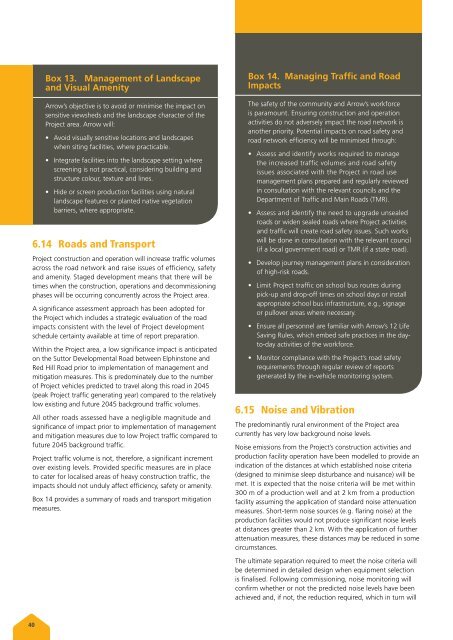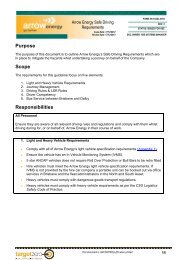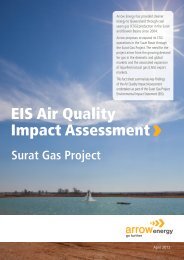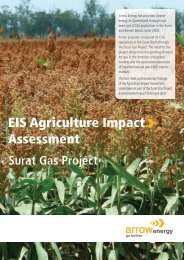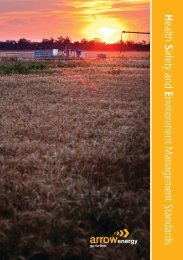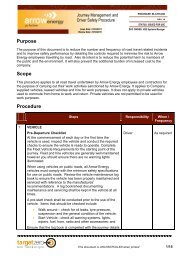Arrow Bowen GAs Project - Arrow Energy
Arrow Bowen GAs Project - Arrow Energy
Arrow Bowen GAs Project - Arrow Energy
Create successful ePaper yourself
Turn your PDF publications into a flip-book with our unique Google optimized e-Paper software.
Box 13. Management of Landscape<br />
and Visual Amenity<br />
<strong>Arrow</strong>’s objective is to avoid or minimise the impact on<br />
sensitive viewsheds and the landscape character of the<br />
<strong>Project</strong> area. <strong>Arrow</strong> will:<br />
• Avoid visually sensitive locations and landscapes<br />
when siting facilities, where practicable.<br />
• Integrate facilities into the landscape setting where<br />
screening is not practical, considering building and<br />
structure colour, texture and lines.<br />
• Hide or screen production facilities using natural<br />
landscape features or planted native vegetation<br />
barriers, where appropriate.<br />
6.14 Roads and Transport<br />
<strong>Project</strong> construction and operation will increase traffic volumes<br />
across the road network and raise issues of efficiency, safety<br />
and amenity. Staged development means that there will be<br />
times when the construction, operations and decommissioning<br />
phases will be occurring concurrently across the <strong>Project</strong> area.<br />
A significance assessment approach has been adopted for<br />
the <strong>Project</strong> which includes a strategic evaluation of the road<br />
impacts consistent with the level of <strong>Project</strong> development<br />
schedule certainty available at time of report preparation.<br />
Within the <strong>Project</strong> area, a low significance impact is anticipated<br />
on the Suttor Developmental Road between Elphinstone and<br />
Red Hill Road prior to implementation of management and<br />
mitigation measures. This is predominately due to the number<br />
of <strong>Project</strong> vehicles predicted to travel along this road in 2045<br />
(peak <strong>Project</strong> traffic generating year) compared to the relatively<br />
low existing and future 2045 background traffic volumes.<br />
All other roads assessed have a negligible magnitude and<br />
significance of impact prior to implementation of management<br />
and mitigation measures due to low <strong>Project</strong> traffic compared to<br />
future 2045 background traffic.<br />
<strong>Project</strong> traffic volume is not, therefore, a significant increment<br />
over existing levels. Provided specific measures are in place<br />
to cater for localised areas of heavy construction traffic, the<br />
impacts should not unduly affect efficiency, safety or amenity.<br />
Box 14 provides a summary of roads and transport mitigation<br />
measures.<br />
Box 14. Managing Traffic and Road<br />
Impacts<br />
The safety of the community and <strong>Arrow</strong>’s workforce<br />
is paramount. Ensuring construction and operation<br />
activities do not adversely impact the road network is<br />
another priority. Potential impacts on road safety and<br />
road network efficiency will be minimised through:<br />
• Assess and identify works required to manage<br />
the increased traffic volumes and road safety<br />
issues associated with the <strong>Project</strong> in road use<br />
management plans prepared and regularly reviewed<br />
in consultation with the relevant councils and the<br />
Department of Traffic and Main Roads (TMR).<br />
• Assess and identify the need to upgrade unsealed<br />
roads or widen sealed roads where <strong>Project</strong> activities<br />
and traffic will create road safety issues. Such works<br />
will be done in consultation with the relevant council<br />
(if a local government road) or TMR (if a state road).<br />
• Develop journey management plans in consideration<br />
of high-risk roads.<br />
• Limit <strong>Project</strong> traffic on school bus routes during<br />
pick-up and drop-off times on school days or install<br />
appropriate school bus infrastructure, e.g., signage<br />
or pullover areas where necessary.<br />
• Ensure all personnel are familiar with <strong>Arrow</strong>’s 12 Life<br />
Saving Rules, which embed safe practices in the dayto-day<br />
activities of the workforce.<br />
• Monitor compliance with the <strong>Project</strong>’s road safety<br />
requirements through regular review of reports<br />
generated by the in-vehicle monitoring system.<br />
6.15 Noise and Vibration<br />
The predominantly rural environment of the <strong>Project</strong> area<br />
currently has very low background noise levels.<br />
Noise emissions from the <strong>Project</strong>’s construction activities and<br />
production facility operation have been modelled to provide an<br />
indication of the distances at which established noise criteria<br />
(designed to minimise sleep disturbance and nuisance) will be<br />
met. It is expected that the noise criteria will be met within<br />
300 m of a production well and at 2 km from a production<br />
facility assuming the application of standard noise attenuation<br />
measures. Short-term noise sources (e.g. flaring noise) at the<br />
production facilities would not produce significant noise levels<br />
at distances greater than 2 km. With the application of further<br />
attenuation measures, these distances may be reduced in some<br />
circumstances.<br />
The ultimate separation required to meet the noise criteria will<br />
be determined in detailed design when equipment selection<br />
is finalised. Following commissioning, noise monitoring will<br />
confirm whether or not the predicted noise levels have been<br />
achieved and, if not, the reduction required, which in turn will<br />
40


